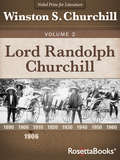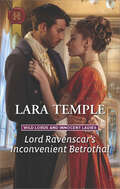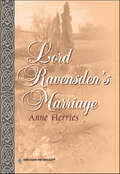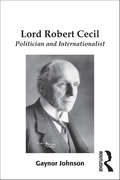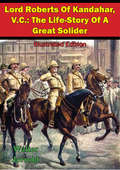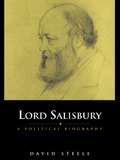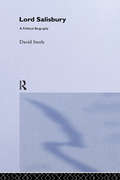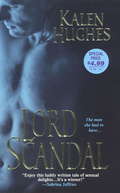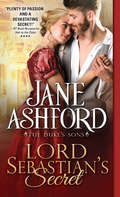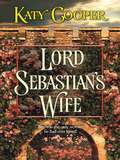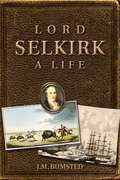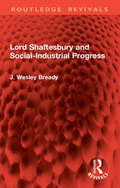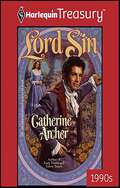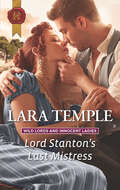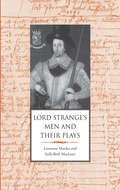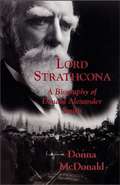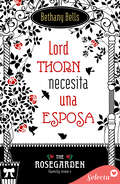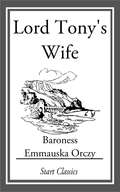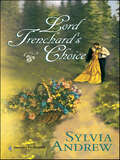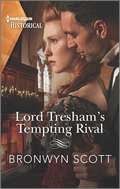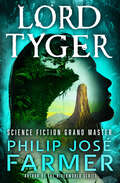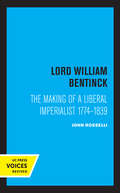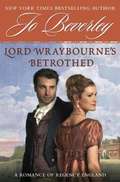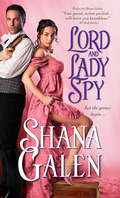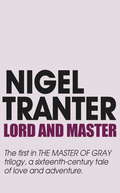- Table View
- List View
Lord Randolph Churchill Volume 2 (Lord Randolph Churchill #2)
by Winston S. ChurchillThe second volume of the Nobel Prize-winning Prime Minister&’s biography of his father, the controversial Victorian era British MP. In 1906, Sir Winston Churchill produced a two-volume biography of his father Lord Randolph Churchill, the 19th century Member of Parliament whose political career ended in scandal. This second volume detail&’s the elder Churchill&’s emergence as an independent leader who challenged the old guard of his own Conservative Party. As an obscure and overlooked backbench MP, Randolph established a cohort of Tory rebels known as the &“fourth party.&” Though excluded from British high society, he nevertheless made a name for himself and rose to become Chancellor of the Exchequer. But as he was on course to run for Prime Minister, his confrontational style led to a career-ending blunder.
Lord Ravenscar's Inconvenient Betrothal (Wild Lords and Innocent Ladies #2)
by Lara TempleA marquess and a stubborn heiress are trapped together—and the only solution is marriage . . . “Will thrill Regency fans.” —RT Book ReviewsAlan Rothwell, Marquess of Ravenscar, is furious when unconventional heiress Lily Wallace refuses him purchase of her property. He can’t even win her over with his infamous charm.But then he is seized by fever and they’re trapped together. Horrified, Alan realizes Lily’s attentions will compromise them both! His solution: take Lily as his betrothed before desire consumes them completely . . .“Ms. Temple has a real gift at creating deeply emotional and passionate characters.” —Chicks Rogues and Scandal“Temple has a delightful gift with words.” —RT Book Reviews
Lord Ravensden's Marriage
by Anne HerriesA young woman disappears. A husband is suspected of murder. Stirring times for all the neighborhood.When the debauched Marquis of Sywell won Steepwood Abbey years ago at cards, it led to the death of the then Earl of Yardley. Now he's caused scandal again by marrying a girl out of his class- and young enough to be his granddaughter! After being married only a short time, the marchioness has disappeared, leaving no trace of her whereabouts. There is every expectation that yet more scandals will emerge, though no one yet knows just how shocking they will be.Regency DramaIntrigue, mischief...and marriageThe Steepwood Scandal
Lord Robert Cecil: Politician and Internationalist
by Gaynor JohnsonLawyer, politician, diplomat and leading architect of the League of Nations; Robert Cecil, 1st Viscount Cecil of Chelwood, was one of Britain's most significant statesmen of the twentieth century. His views on international diplomacy cover the most important aspects of British, European and American foreign policy concerns of the century, including the origins and consequences of the two world wars, the disarmament movement, the origins and early course of the Cold War and the first steps towards European integration. His experience of the First World War and the huge loss of life it entailed provoked Cecil to spend his life championing the ethos behind and work of the League of Nations: a role for which he was awarded the Nobel Peace Prize in 1937. Yet despite his prominence in the international peace movement, Cecil has never been the focus of an academic biography. Cecil has perhaps been judged unfairly due to his association with the League of Nations, which has since been generally regarded as a failure. However, recent academic research has highlighted the contribution of the League to the creation of many of the institutions and precepts that have, since the Second World War, become accepted parts of the international system, not least the United Nations. In particular, Cecil and his work on arms control lay the basis for understanding this new area of international activity, which would bear fruit during the Cold War and after. Through an evaluation of Cecil's political career, the book also assesses his reputation as an idealist and the extent to which he had a coherent philosophy of international relations. This book suggests that in reality Cecil was a Realpolitiker pragmatist whose attitudes evolved during two key periods: the interwar period and the Cold War. It also proposes that where a coherent philosophy was in evidence, it owed as much to the moral and political code of the Cecil family as to his own experiences in politics. Cecil's social and familial world is therefore considered alongside his more public life.
Lord Roberts Of Kandahar, V.C.: The Life-Story Of A Great Solider [Illustrated Edition]
by Walter JerroldIncludes 9 illustrations"As a leader of men in the field he is, I believe, without equal." -- Sir Alfred Milner on Lord RobertsIn this excellent short biography of Lord Roberts, Walter Jerrold, tells the tale of his many exploits and victories across the British Empire."Roberts won the Victoria Cross at Khudagani during the Indian Mutiny (1857-59) for repeated acts of gallantry, but first came to public notice during the Second Afghan War (1878-80) when he commanded the Kurram Field Force, leading it to victory at Peiwar Kotal in December 1878, and later the Kabul Field Force which occupied the Afghan capital in October 1879 following the murder of the British envoy."Roberts also led his troops on the legendary march from Kabul to Kandahar. Despite the difficult terrain and the high temperatures he covered 280 miles (400km) in 20 days and hardly lost a man. In September 1880 he defeated Ayub Khan outside Kandahar and relieved the besieged garrison. "After the early reverses of the Boer War (1899-1902), Roberts took over command of the British forces in South Africa. From December 1899, together with his Chief of Staff Major-General Horatio Herbert, Lord Kitchener, he revitalised the British military effort. Kindly, unassuming and courteous, Roberts was popularly known as 'Bobs'. His small stature and elderly appearance - he was 68 when he left South Africa in 1900 - probably increased the veneration which he received from both the public and soldiers."On returning to Britain he was made a Knight of the Garter and created Earl Roberts. Despite a bitter rivalry with the Wolseley ring, Roberts was made the last Commander-in-Chief of the British Army, a position he held for three years until 1904.After lying in state in Westminster Hall, one of only two non-Royals to do so in the 20th century, the other being Winston Churchill, he was given a state funeral."--NAM
Lord Salisbury: A Political Biography
by Dr E SteeleFirst published in 1999. Routledge is an imprint of Taylor & Francis, an informa company.
Lord Salisbury: A Political Biography
by Dr E SteeleThis book presents a study of Lord Salisbury, British prime minister in the late nineteenth century and early twentieth century, whose political philosophy was reactionary and defeatist, and who is remembered for an irony that was wounding as well as diverting.
Lord Scandal
by Victoria Dahl Kalen HughesA Shocking Scandal. . .The last thing the Portrait Divorcée needs is to have her name connected to that of the equally infamous Brimstone. But the infuriating rake has made it very clear that he's bent on nothing less than her complete surrender. Rich widows take lovers. Poor divorcées become mistresses. And those with powerful families tread carefully, lest they incite their family's wrath, a tragic outcome she's all too familiar with. . .Is Well Worth The Pleasure. . .Gabriel Angelstone, the handsome scourge of the ton, has taken one of life's lessons to heart: Love ruins everything. But the irresistible challenge of seducing Imogen Mowbray, a woman whose past is every bit as scandalous as his own, quickly has him rethinking that conclusion. Perhaps the only women worth loving are the fallen ones. . . "Lusty and delicious!"--Julia Ross on Lord SinKalen Hughes was born and raised in Northern California. She grew up participating in a wide variety of historical reenactment clubs, which has given her an unusually personal perspective on history, which she hopes brings added verisimilitude to her writing. She has taught creative writing, horseback riding, and is an active costume historian. She can drive stick (even on the hills of San Francisco), and start a fire without matches, as well as make a soufflé, and hitch a team of horses to a wagon (albeit not at the same time). Currently, she lives in the San Francisco Bay Area with an ancient pit bull terrier, and can often be found writing in one of the many local coffee shops.
Lord Sebastian's Secret
by Jane AshfordHe's hidden this shameful secret all his life...Lord Sebastian Gresham is a battle tested soldier and brilliant strategist. Yet all his life he's had to hide his complete failure to decipher letters. In his own mind, he's just stupid. What a miracle it is that he's found the perfect bride. Lady Georgina Stane is beautiful, witty, and brilliantly intelligent. Sebastian is head over heels in love, proud as a peacock, and terrified. If she finds out, he'll lose her love forever.The Duke's Sons Series: Heir to the Duke (Book 1) What the Duke Doesn't Know (Book 2)Lord Sebastian's Secret (Book 3)Praise for Heir to the Duke: "Plenty of passion and a devastating secret in this heartwarming and compelling read." -RT Book Reviews, 4 Stars"Fabulous romance with wonderful characters... I couldn't put this book down." -Night Owl Reviews, Reviewer Top Pick!
Lord Sebastian's Wife
by Katy CooperHe had broken every promise he had ever made her... And her heart with them!A reckless promise, made in the glow of first love, now bound Lord Sebastian Benbury to the Lady Beatrice. But though her beauty still stirred his inner fires, nothing could burn away the far-off memory of her with another man!
Lord Selkirk: A Life
by J.M. BumstedThomas Douglas, the Fifth Earl of Selkirk (1770–1820), was a complex man of his times, whose passions left an indelible mark on Canadian history. A product of the Scottish Enlightenment and witness to the French Revolution, he dedicated his fortune and energy to the vision of a new colony at the centre of North America. His final legacy, the Red River Settlement, led to the eventual end of the dominance of the fur trade and began the demographic and social transformation of western Canada. The product of three decades of research, this is the definitive biography of Lord Selkirk. Bumsted’s passionate prose and thoughtful analysis illuminate not only the man, but also the political and economic realities of the British empire at the turn of the nineteenth century. He analyzes Selkirk’s position within these realities, showing how his paternalistic attitudes informed his “social experiments” in colonization and translated into unpredictable, and often tragic, outcomes. Bumsted also provides extensive detail on the complexities of colonization, the Scottish Enlightenment, Scottish peerage, the fur trade, the Red River settlement, and early British-Canadian politics.
Lord Shaftesbury and Social-Industrial Progress (Routledge Revivals)
by J. Wesley BreadyOriginally published in 1926, this volume is much more than a biography of an outstanding politician, social reformer and philosopher. It provides an analysis of the history of social conditions in England during the nineteenth century, as well as a discussion of the development of social affairs and the inertia of political psychology. The role that faith and religion played in motivating Lord Shaftesbury’s desire for social reform is also discussed as is the ways in which he and John Wesley transformed the social and ethical ideas of England to enshrine in law many of the working conditions that we take for granted today such as defined hours of work and rest periods.
Lord Sin
by Catherine ArcherThe Infamous Lord Sin Had Taken A WifeIan Sinclair, the lord of ill repute, had married a country vicar's daughter. Now he was sure there'd be the devil to pay, for the passionate Mary Fulton was the woman he held above all others, and a woman he knew he didn't deserve.The more she learned of Ian's world of privilege, the more Mary Fulton realized how impossible their union really was. Yet the web of gentle passion woven on their wedding night grew stronger with every touch they shared...!
Lord Stanton's Last Mistress (Wild Lords and Innocent Ladies #3)
by Lara TempleHe’s finally found the woman who saved his life—and now he can’t resist her—in this passionate Regency by an author with “a delightful gift with words” (RT Book Reviews).Lord Stanton’s long-ago stay on the island of Illiakos is shrouded in memories of fever—and his mysterious nurse. Years later, an Illiakan royal visit to Stanton Hall reveals the princess’s chaperone, Christina James, is the woman who saved his life.Alexander is a master of control, but Christina makes him long to unleash the sinful side he’s buried—and unlock her passionate nature, too . . .Praise for the series“Will thrill Regency fans.” —RT Book Reviews on Lord Ravenscar’s Inconvenient Betrothal“Quite the swoon-worthy hero.” —All About Romance on Lord Hunter’s Cinderella Heiress
Lord Strange's Men and Their Plays
by Prof. Lawrence Manley Prof. Sally-Beth MacLeanIn this major contribution to theater history and cultural studies, authors Lawrence Manley and Sally-Beth MacLean paint a lively portrait of Lord Strange's Men, a daring company of players that dominated the London stage for a brief period in the late Elizabethan era. During their short theatrical reign, Lord Strange's Men helped to define the dramaturgy of the era, performing the works of William Shakespeare, Christopher Marlowe, Thomas Kyd, and others in a distinctive and spectacular style, exploring innovative new modes of impersonation while intentionally courting political and religious controversy.
Lord Strathcona: A Biography of Donald Alexander Smith
by Donna McdonaldDonald Smith, known to most Canadians as Lord Strathcona, was an adventurer who made his fortune building railroads. He joined the Hudson’s Bay Company at age eighteen and went on to build the first railway to open the Canadian Northwest to settlement. As his crowning achievement, he drove the last spike for the nation-building Canadian Pacific Railway. In 1896, Smith became Canada’s High Commissioner in London and was soon elevated to the peerage. He became a generous benefactor to Canadian institutions. This eminently readable biography brings to light new information, including details about Strathcona’s personal life and his scandalous marriage.
Lord Thorn necesita una esposa (The Rosegarden Family Tree #Volumen 1)
by Bethany Bells¿Permitirá el amor que su matrimonio se reduzca a un simple acuerdo práctico? Cuando lord Thorn Rosegarden, heredero de una familia arraigada en un oscuro misterio, se plantea el matrimonio, no lo hace por una cuestión de amor, sino para solucionar un problema doméstico inmediato. Por lo tanto, debe ser algo que no estorbe y que le permita seguir haciendo lo que siempre ha querido: disfrutar al máximo de la vida.Lady Rosalynn es consciente de que no tiene muchas opciones en la vida. Sus padres fallecieron y el título y la fortuna pasaron a unos familiares lejanos con los que no tiene trato alguno. Su situación económica, muy precaria, la llevó a buscar empleo de institutriz y la suerte hizo que, con ello, recibiese una propuesta matrimonial tan inesperada como fría.Ninguno de los dos imagina que, pese a todo, están destinados a conocer lo que es de verdad estar enamorado.
Lord Tony's Wife
by Emmauska OrczyBaroness Emma Magdolna Rozália Mária Jozefa Borbála "Emmuska" Orczy de Orczi (23 September 1865 - 12 November 1947) was a Hungarian-born British novelist, playwright and artist of noble origin. She is most known for her series of novels featuring the Scarlet Pimpernel. This is one of her novels.
Lord Trenchard's Choice
by Sylvia AndrewThe Rake’s ProposalNo society beauty had been able to tempt Lord Ivo Trenchard to give up the single life. None, that was, until he met an enchanting innocent-in boy’s clothes-who challenged him to teach her how to kiss!He watched in amazement as the wild tomboy transformed into a stunningly elegant lady who took all of London by storm. His offer of marriage took them both by surprise.Was he merely protecting Joscelin Morley from a threatening scandal-or was she his true choice, his only love?
Lord Tresham's Tempting Rival (The Peveretts of Haberstock Hall #1)
by Bronwyn ScottNothing in commonExcept an intoxicating attraction! Sharing a steamy kiss with Anne Peverett at a Christmas ball is utterly out of character for Dr. Lord Ferris Tresham. He&’s far too busy treating London&’s poor to court anyone. Until Anne is revealed as the herbalist who&’s been treating his patients with her homemade remedies! If they unite forces, will Anne be a bigger threat to his practice…or his closed-off heart? From Harlequin Historical: Your romantic escape to the past.The Peveretts of Haberstock Hall Meet the philanthropic Peverett siblings: unconventional, resourceful and determined to make a difference in the world.Book 1: Lord Tresham's Tempting RivalBook 2: Saving Her Mysterious Soldier
Lord Tyger
by Philip José FarmerA South African tycoon attempts to engineer his own Tarzan in a novel that deconstructs the original legend with unparalleled imagination. In a remote African valley, Ras Tyger is the Lord of the Jungle. He lives each day fulfilling his appetites for deadly prey and sexual conquest. But something sinister lurks behind his unspoiled life. He will soon discover the devastating truth: his entire existence has been engineered by a madman. Obsessed with the Tarzan novels of Edgar Rice Burroughs, a white South African uses his fortune to turn an English nobleman into the heroically untamed figure. Everything in Ras Tyger&’s world—from his jungle home to the &“apes&” who raised him—is an elaborate lie. But the Tarzan books weren&’t very plausible. And the experiment is about to get dangerously out of control . . . Drawing on true stories of feral children, Lord Tyger explores the real-life implications of the Tarzan legend. With ingenious meta-fiction, Philip José Farmer delivers a wildly entertaining sci-fi adventure that critiques popular colonial mythmaking.
Lord William Bentinck: The Making of a Liberal Imperialist 1774 - 1839
by John RosselliThis title is part of UC Press's Voices Revived program, which commemorates University of California Press’s mission to seek out and cultivate the brightest minds and give them voice, reach, and impact. Drawing on a backlist dating to 1893, Voices Revived makes high-quality, peer-reviewed scholarship accessible once again using print-on-demand technology. This title was originally published in 1974.
Lord Wraybourne's Betrothed: A Romance of Regency England
by Jo BeverleyFrom The New York Times bestselling author of A Lady?s Secret, a classic Regency romance back in print and in trade for the first time.Even if the handsome, debonair Lord Wraybourne is only marrying Jane Sandiford for her fortune?as she suspects?that does not diminish the powerful sway her betrothed seems to hold over her. The Sandiford Heiress has lived a sheltered life and is known for being stuffy, so her passionate responses to her fiancé?s attentions catch her by surprise. As confused and mortified as she is by her own emotions, Jane is even more scandalized when the dread Whisperer, the scourge of polite Society, rasps unspeakable vileness into her ear. And she is troubled by the news that someone is assaulting young women ?of the middling class? in the streets of London. Yet she remains unaware that an adversary closer to home schemes to sabotage the relationship between Lord Wraybourne and his betrothed?
Lord and Lady Spy
by Shana GalenLord Adrian and Lady Bridget Smythe have the pictureperfect high society marriage. Little does the ton know that each is one of England's most preeminent spies– with their secret identities guarded even from each other. But what are secret agents to do when the spying game is over and they suddenly discover a whole new spark in each other?
Lord and Master: Master of Gray trilogy 1
by Nigel TranterBorn of one of Scotland's noblest families, Patrick Gray was fascinating, irresistible, ambitious and ruthless. Involved in a daring plot to free the imprisoned Mary Queen of Scots, and immersed in the intrigues of Elizabeth I's Tudor court, he strode imperiously across the turbulent stage of European history, crushing those who resisted his legendary charm. The great events of the sixteenth century provide a colourful backdrop to this stirring tale of love, adventure and betrayal. 'Through his imaginative dialogue, he provides a voice for Scotland's heroes' Scotland on Sunday
